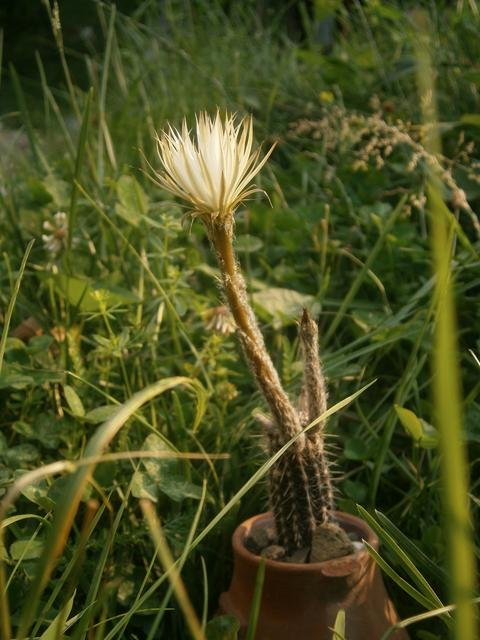🌸 Dessert.plants.passion / Echinopsis mirabilis / Miraculous Creature

Echinopsis mirabilis
The nature is wonderful, it gives us so many amazing creatures to admire!
Now I know that it is not surprising at all that this cactus was named 'mirabilis', but I have to admit I didn’t notice it’s specialty at the first glance. 15 years ago at the flower fair in Zagreb, Floraart, I came across this plant, and I didn’t even pay attention to it. The cactus grower who was selling it for less than $ 1 told me, ‘Take it, you must have it. You'll see, it will surprise you’. Then he wrote the name of this plant on a small piece of paper and even made a sketch that I still have, and you can see it below. Then I thought I'd give this plant a chance and take one young mirabilis with me. And our journey started.

A drawing of E. mirabilis made by one cactus grower
It is easy plant to grow but not very showy. It looks like a thin stick with spines. Nothing attractive. But then one day on it’s body a hairy bud appeared, slowly growing, becoming elongated like other buds of Cereus or Echinopsis group, but thinner. After days and days waiting one evening when the Sun came down the bud decided to open. Slim, white petals with pointed tips revealed itself in sweet exotic scent. That was it. The moment when I was like bewitched, totally fascinated. Next morning the beauty vanished. It is only one night dancer, just like many Cereus and Echinopsis plants.

E. mirabilis in flower
It is like a plant’s essence is hidden until it reveal its flower. I feel it with every Cacti I have. And this one is so special though it’s noteless appearance and then a surprise; magical flower. I cannot convey it with photos only, you have to smell it 😊, it is perfect natural summertime perfume.
But there is one catch with this plant. It does not live long. It may grow taller than 15 cm, but usually dies long before reaching this height. Fortunately, due to it’s autogamy, it gives hundreds of seeds that germinate very easy.

E. mirabilis with fruits full of seeds and new buds
One of mine reached even 24 cm and lived for 15 years! That one was most special, and that was the first one I had, the one I bought on flower fair from the beginning of this story. Of course I had grown many from it’s seeds, and will continue with this practice of sawing E. mirabilis every year. That is the plant that every cactus collector must have.

E. mirabilis, 24 cm height and branched in last (15.) year of his life. This one unexpectedly lived for a long time compared to others of that species.
Accepted name for this plant is Echinopsis mirabilis though it is more related to Cereus group of plants. Today many scientists are making great effort in genetic studies of Cactaceae which will show more about it’s genetic affiliations. I’m reading those very interesting discoveries, that are sometimes surprising us all with some unexpected genetic relations between these ’echinus’ beauties.
One of the researches that you can read about here came out with the conclusion of close relationship between Denmoza rhodacantha, E. mirabilis, E. leucantha and Acantocalycium. All of them are endemic to Argentina and their flowers are not adapted to the same pollinator. The star of today’s story E. mirabilis is pollinated by moths, Denmoza by hummingbirds, and Acanthocalycium by bees. What else will these genetic studies discover? I ever wait to some more publishing.

E. mirabilis begin to flower in it’s second or third year from seeds
I have prepared some of my own seeds of E. mirabilis for this spring sowing. Exotic scented flowers closing before dawn and short life cycle makes this plant truly unique, I have to include this magnificent plant in ‘pack’ of new living beings that are coming in my greenhouse every year. It was plan of the nature, how amazing, that this plant have capability to seduce us in it’s short life and then, due to generously seeds giving, continue with it’s ‘mirabile’ trough other generations.
Thank you for your attention!
Some of my other cacti & other succulents stories:
My 2018 - This is my Hobby: Growing Stone Eaters
Dessert.plants.passion / Stapeliads / Flower Seduces Flies!
Lithops in Flower
Titanopsis in Winter Dormancy
My Cactus World of Joy
If you are interested in reading about desert plants from my own growing experience fell free to follow and enjoy!
@andrijana